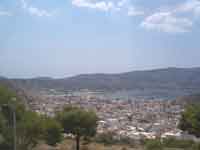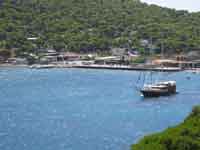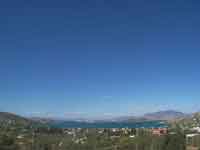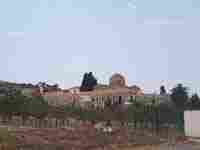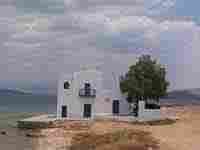.


Administrative Region : Attica
Regional unit : Islands
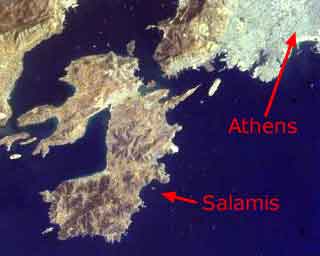
Salamis (Greek: Σαλαμίνα Salamína, Ancient and Katharevousa: Σαλαμίς Salamís), is the largest Greek island in the Saronic Gulf, about 1 nautical mile (2 km) off-coast from Piraeus and about 16 km west of Athens. The chief city, Salamina (city), lies in the west-facing core of the crescent on Salamis Bay, which opens into the Saronic Gulf. The island's main port, Paloukia, in size second only to Piraeus, is on the eastern side.
History
Evripidio theatre in Salamina.
Salamis is mentioned in Homer's writings. Some sources say it was named after the nymph Salamis, according to legend the mother of Cychreus, the first king of the island). Another theory, that is supported by modern linguistics, considers "Salamis" to come from the root "Sal-" (meaning salty water) and "-amis" (meaning the middle); thus Salamis = (the place) amid salt water.[1]
Salamis was probably first colonised by Aegina and later occupied by Megara, but became an Athenian possession in the time of Solon or Peisistratos, following the war between Athens and Megara around 600 BC.[2] According to Strabo, the ancient capital was at the south of the island;, and in classical times it was to the east, on the Kamatero Peninsula overlooking the Strait of Salamis; in modern times it is on the west.[3]
Salamis island is known for the Battle of Salamis, the decisive naval victory of the allied Greek fleet, led by Themistocles, over the Persian Empire in 480 BC. It is said to be the birthplace of Ajax and Euripides, the latter's birth being popularly placed on the day of the battle. In modern times, it is home to Salamis Naval Base, headquarters for the Hellenic Navy.
The oldest known counting board was discovered on the Greek island of Salamis in 1899.[4] It is thought to have been used by the Babylonians in about 300 BC and is more of a gaming board rather than a calculating device. It is marble, about 150 x 75 x 4.5 cm, and has carved Greek symbols and parallel grooves.
Ampelakia.

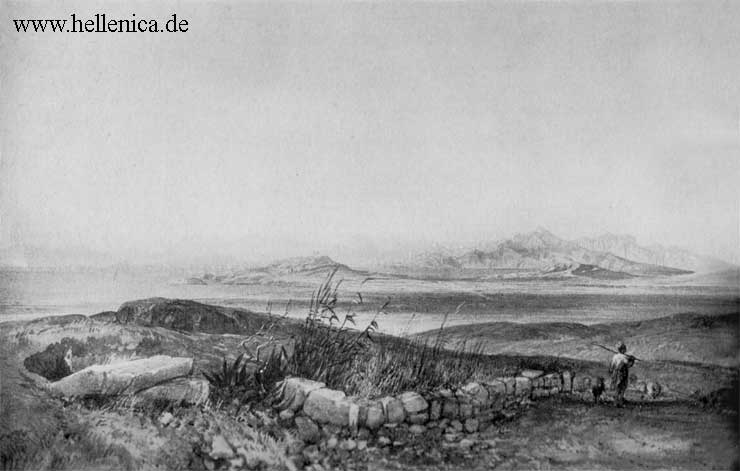
Salamis 1838
During the German invasion of Greece in World War II, the harbor was bombed by the Luftwaffe on April 23, 1941, sinking the Greek battleships Kilkis and Lemnos.[5][6]
In the 1960s and 1970s, during the military junta period, changes in land legislation allowed the subdivision of land plots.[7] This opened the island to massive unplanned and unregulated urban and suburban development, including many weekend homes, especially along the northern and eastern coasts. The lack of corresponding investment in infrastructure, combined with heavy industry, has led to sea and beach pollution on this side of the island. There are, however, ongoing initiatives such as help from the European Union’s Cohesion Fund toward improving sewerage by 2008.[8]
Geography
Salamis island map.
Salamis has an area of 36 square miles; its highest point is Mavrovouni (1325 feet). A significant part of Salamis Island is rocky and mountainous. On the southern part of the island a pine forest is located, which is unusual for western Attica. Unfortunately, this forest is often a target for fires.[8] While the inland inhabitants are mainly employed within the agricultural sector, the majority of Salamis' inhabitants work in maritime occupations (fishing, ferries, and the island's shipyards) or commute to work in Athens.[9][10] The maritime industry is focused on the north-east coast of the island at the port of Paloukia (Παλούκια), where ferries to mainland Greece are based, and in the dockyards of Ampelakia and the north side of the Kynosoura (Greek: Κυνοσούρα = "dog tail") peninsula.
Salamis Island is very popular for holiday and weekend visits from the Athens and Piraeus area; its population rises to 300,000 in peak season of which ca. 31,000 are permanent inhabitants.[8] This supports a strong service industry sector, with many cafes, bars, ouzeries, tavernas and consumer goods shops throughout the island. On the south of the island, away from the port, there are a number of less developed areas with good swimming beaches including those of Aianteio, Maroudi, Perani, Peristeria, Kolones, Saterli, Selenia and Kanakia.[11]
Municipality
Salamis Island belongs to the Islands regional unit of the Attica region. Since the 2011 local government reform the island is administered as one municipality. Before, the island was divided into two municipalities, that became municipal units at the reform:[12]
Salamina
Ampelakia
In the municipal unit of Salamina, which has a land area of 80.992 km² and a 2001 census population of 30,962, the chief population centre is the city of Salamina (also called Salamis, Salamis City or Koulouris, pop. 25,730 in 2001), consisting of the districts Alonia, Agios Minas, Agios Dimitrios, Agios Nikolaos, Boskos, Nea Salamina, Tsami and Vourkari.[CN] Its second-largest town is Aiánteio (pop. 4,456). In the municipal unit of Ampelakia, which has a land area of 15.169 km² and a population of 7,060, the largest towns are Ampelakia (pop. 4,537) and Selinia (2,346).
Population
As of the mid-20th century, the majority of the inhabitants were Arvanite; a thing that changed during the past 20 years due to settlement of a lot of Athenians on the island to the degree that nowadays Arvanites are a fraction of the population, living mainly in Salamina town, Ampelakia and Moulki (Aianteion).[13] The island is known in Arvanitika as Κȣλλȣρι ("Koullouri").
Year Salamina (town) Salamina (municipality) Salamis (island)
1981 20,807 25,215 30,402
1991 22,567 27,582 34,342
2001 25,730 30,962 38,022
Villages in the municipal unit of Salamina
Paloukia
Paloukia (Greek: Παλούκια) (Population 1.695) which means Poles in English, is located in the northeast of the island. Many ferryboats, fishing vessels and port police craft dock in this harbor. Paloukia is the base for the port police department of Salamina. Most visitors who come to Salamina first arrive at Paloukia via ferryboats that run between Paloukia and Perama or Piraeus.
The area is adjacent to the Salamis Naval Base (in Greek Nafstathmos), which is a major base of the Hellenic Navy.
Aianteio
Aianteio or Aiantio or Eantio (Greek: Αιάντιον), (Modern Greek: Αιάντειο) (older forms Aiantio, Aiandion, Eantion and Eandion—transliteration may vary) is a large village in the southwestern part of Salamis Island and is named after Ajax, from Homer's Iliad, "King of the Salamis". The village in the medieval times and until the late-20th century was known as Moulki (Μούλκι).
In the region, there are churches of the 12th and the 11th century such as Saint John and Saint Dimitrios.
Interesting places to visit are:
the oldest church in the island, Saint John the "Kalyvitis", which dates back in the 10th century and has remarkable hagiographies, and
the monastery of Saint Nicolas which dates back in the 18th century and is situated in a forest.
Batsi
Batsi beach
Batsi or Mpatsi (Greek, Modern: Μπατσί, Ancient/Katharevousa: -on), older forms Batsion is a little community (population 212) in the north of Salamis, in the municipality of Salamis, located at the foot of a piney mountain, about 6 to 8 km E of Megara.
In the mountain, there is a cave of archeological interest that has not been investigated yet. In the winter there are few tourists; it is more popular with vacationers from Athens during the summer months.
Kaki Vigla
Kaki Vigla (Greek: Κακή Βίγλα), (translated Bad View in Greek) is a small community (Population 236) located at the south of Salamis Island, near Aianteio.
The beaches of Kaki Vigla are relatively clean and the area has pine and olive trees near the shore.
Agios Georgios
A new village, founded in 1960.
Peristeria
Peristeria (Greek: Περιστέρια) (Population 456) is a small village at the southeast of Salamis Island, 45 km from Salamis City. It took its name from the bird of peace, the pigeon (Greek: περιστέρι), because it is a calm, peaceful and isolated place, away from the cars and from noise. Another interpretation says that its name may be derived from the doves which were living and had nests in the area.
The area has a marina, which has yachts and fishing boats. The beaches of Peristeria are the cleanest of Salamis. The village is near the Cave of Euripides.
Psili Ammos
Psili Ammos (Greek: Ψιλή Άμμος) (Population 271), which means Fine Sand is so named because it is covered with sand. The area is located at the northwest of the island opposite of Elefsina. In the area there is one of the oldest landmarks, a church building of island, the chantry of Saint Grigorios (Saint Gregory).
Steno
Steno (Greek: Στενό) (Population 985), which means Narrow in Greek, is a small community in the northwest of Salamis Island. The area is separated from Fanaromeni Monastery by a hill with shrubs and pine trees. The area is adjacent to the bay of Agios Georgios. Steno has wide and well-planned roads.
Vasilika
Vasilika (Greek: Βασιλικά) (Population 4.264) which means Royally is a big village in Salamis Island, located in the northwest of the island. Vasilika is the third area in Salamis by population after Salamis City and Aianteio. Vasilika has a sandy large beach apt for swimming.
Xeno
Xeno (Greek: Ξένο) (Population 786) which means Foreign in English is located at the northwest of the island. The area took this name because the first residents who came in Xeno were not from Salamis but from the close areas of Pireaus.
Villages in the Municipality of Ampelakia
Kynosoura
Kynosoura or Kinosoura (Greek: Κυνόσουρα), which means the tail of dog (Greek: κυνός-ουρά) in Ancient and Modern Greek, is a small peninsula at Salamis Island, located in the east of island. The area probably took its name, because the area is long and oblong, such as a dog' s tail. At the south side of area there are a few houses (Population 69). At the north there is a dockyard, which constructs and fixes any type of ship like: oilers, transports, containers etc.
Selinia
Selinia (Greek: Σελήνια)(Population 2.523) is one of the resorts of Salamis Island, Greece, located a few kilometers southeast of Salamis city . Selinia used to be the weekend resort of many Athenians due to its proximity to Piraeus and Athens. Selinia also features restaurants and taverns.
Geography
Its geography includes residential areas around the area and farmlands in its outskirts. The mountains that features grasslands and barren land along with forests dominates the outer areas.
Culture
Euripides.
Ajax.
Famous mythological and ancient people
Ajax the Great, the legendary king of Salamis island, son of Telamon and half-brother of Teucer
Cychreus, the first king of Salamis Island
Euripides, tragedian (485 or 480 B.C. - 406 B.C.)
Telamon, the king of Salamis Island, father of Ajax the Great and Teucer
Teucer, the half-brother of Ajax the Great, son of Telamon, warrior of Trojan War, and founder of the city-state of Salamis, Cyprus.
Modern celebrities
Georgios Karaiskakis (c.1780-1827), Greek War of Independence hero, is buried on Salamis.
Dimitrios Mpogris (1890–1964), playwright
Polychronis Lempesis (1848–1913), painter
Angelos Sikelianos (1884–1951), poet and playwright, whose cottage was near the Monastery of Faneromeni.
Giorgos Papasideris (1902–1977), country singer, composer and lyricist
Memos Mpegnis (1974-), actor
Giorgos Vasileiou, actor, former representative of the Hellenic Parliament and councilman of the Salamina municipality, has his permanent residence in the Batsi area.
Education
Salamis island has eleven primary schools (ten public and one private), four high schools and four lycees. The majority of students are proficient in school, and usually the pupils (above age 13) have acquired diplomas and certificates in English, French or in German like ECCE, FCE, CPE, ECPE and others. Many students from Salamis island also possess many computer skills. Many students also study abroad, usually in countries such as the United States, United Kingdom, Germany, and France. In the 1960s, 1970s and 1980s, the pupils went to Italy for studies since it was close to Greece.
Recreational areas
On Salamis island, a visitor can find many bars, cafeterias, beaches, shops, with different views of Salamis Bay. The main cafeterias and bars are based at the area of Agios Nikolaos, which is at the west suburbs of Salamis city. The district took its name from the church of the same name. Taverns and inns are in every place of the island with their local food and dishes. The shops are opened from 8:00 up until 2:00 in the morning and at 5:30 to 9:00 in the afternoons during weekdays (also open from 9:00 to 1:30 in the mornings and 6:00 to 8:30 in the afternoons during Saturdays). Salamina has a plethora of shops for clothes, souvenirs, appliances, vehicles, and computers.
Sports
Salamis island has four football teams, Aias (Ajax) Salaminas, Ampelakiakos F.C., A.E. Salaminas and Salaminomachoi
Local newspapers and magazines [14]
Salaminiaki Protoporia (Salaminian Vanguard)
Anatropes (Tippings )
I Enotita tis Salaminas (The Unity of Salamis)
I Nea Salamina (The New Salamis)
I Foni tis Salaminas (The Voice of Salamis)
Neo Ithos tis Salaminas (New Morale of Salamis)
Apopsi (Opinion)
Palmos tis Salaminas (Pulse of Salamis)
Athlitikoi Palmoi (Athletic Vibrations)
Politis me dikaioma ( Citizen with rights)
Sports Week Salamina
30 Imeres tis Salaminas (30 Days of Salamina)
Landmarks
Landmark Year of construction Location
Faneromeni Monastery 15th century Faneromeni
Chantry of Saint George around 1250 Agios Georgios
Euripideio Theatre 1993 in suburbs of Salamis City (in hill Patris)
Church of Saint Dimitrios 1806 center of Salamis City (in hononymous district)
The Cave of Euripides 450 BC at south Salamis Island (near Peristeria)
The Cottage of Angelos Sikelianos 1935 Faneromeni
The Stone Lighthouse 1901 Peristeria
The bust of Georgios Karaiskakis 1982 center of Salamis City (in Vourkari district)
The Windmills 19th century in suburbs of Salamis City (in a hill)
Chantry of Prophet Elias early of 20th century Salamis City (in a stone hill)
Chantry of Saint Grygorios 12th century Psili Ammos
The Stony small Theater 1990 Selinia
The City Hall of Salamis 2000 Salamis City
The Monastery of Saint Nicolaos 17th century at south Salamis Island (near Kanakia)
The Church of Saint John the Kalyvitis 11th century at south Salamis Island (near Kanakia)
The Folklore Museum 2000 it ' s lodging at Salamis City Hall
The Mansion of Galeos Family 19th century at Salamis center (at Agios Minas district)
The Church of Saint Minas 1869 at Salamis City (at Agios Minas district)
International relations
Main article: List of twin towns and sister cities in Greece
Salamis Island is twinned with:
Cyprus Famagusta, Cyprus (1998)
References
^ Place-Names in Classical Mythology: Greece, Robert Eugene Bell, ABC-CLIO, 1989, ISBN 0874365074
^ "Salamis", Oxford Dictionary of the Classical World, Ed. John Roberts. Oxford University Press, 2007.
^ Greece, Blue Guide series, Stuart Rossiter, Ernest Benn, 1981
^ http://users.ju.edu/ssundbe/salamis.html
^ Kilkis (Battleship, 1914-1941), Naval Historical Center
^ Lemnos (Battleship, 1914-1941), Naval Historical Center
^ One-sixth of houses are for vacation use, Kathimerini, 4-19-2006
^ a b c Salamina, so near yet so unknown, Polyxeni Athanassoulia, Kathimerini, 9-7-2006
^ Salamis, Howstuffworks encyclopedia
^ Salamis official website
^ Salamina, Anatropes newspaper site (in Greek)
^ Kallikratis law Greece Ministry of Interior (Greek)
^ Jochalas, Titos P. (1971): Über die Einwanderung der Albaner in Griechenland: Eine zusammenfassene Betrachtung ["On the immigration of Albanians to Greece: A summary"]. München: Trofenik.
^ Newspapers and magazines, Salamis official website (in Greek)
Greece :
A - B - C - D - E - F - G - H - I - J - K - L - M -
N - O - P - Q - R - S - T - U - V - W - X - Y - Z
| Ancient Greece
Science, Technology , Medicine , Warfare, , Biographies , Life , Cities/Places/Maps , Arts , Literature , Philosophy ,Olympics, Mythology , History , Images Medieval Greece / Byzantine Empire Science, Technology, Arts, , Warfare , Literature, Biographies, Icons, History Modern Greece Cities, Islands, Regions, Fauna/Flora ,Biographies , History , Warfare, Science/Technology, Literature, Music , Arts , Film/Actors , Sport , Fashion --- |
Retrieved from "http://en.wikipedia.org/"
All text is available under the terms of the GNU Free Documentation License



